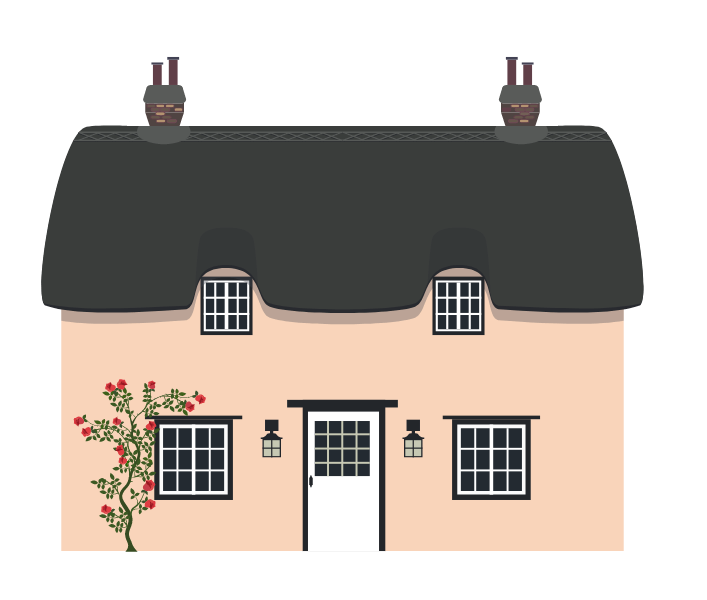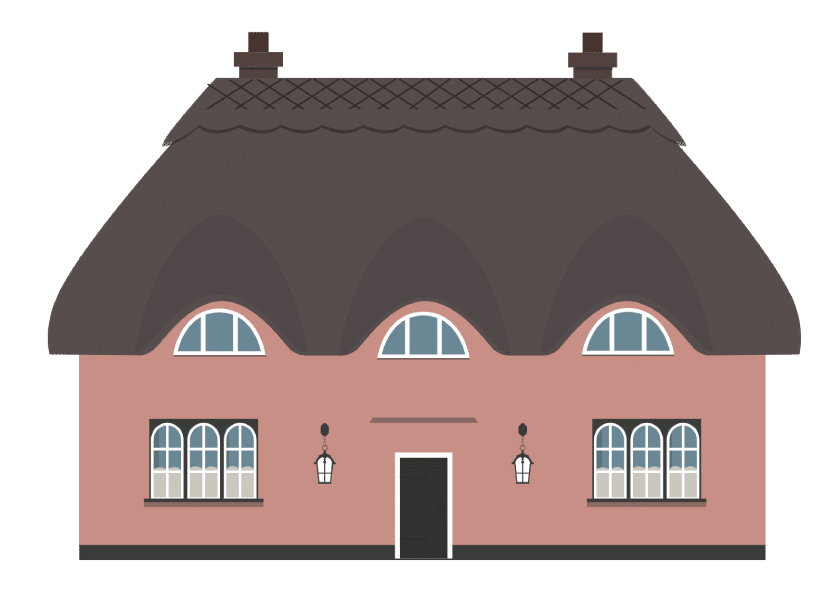Thatched properties offer instant kerb appeal and a unique chocolate box allure.
There are around 60,000 thatched roof properties in Britain, and approximately 75% of these hold a listed building status.
These aspects, combined with having a non-standard construction, can complicate the process of getting a mortgage. But they are available.
Are mortgages available?
Yes, most lenders will consider lending on thatched properties.
While thatched roofs may be categorised as non-standard construction, due to age and potential listed status, lenders still view them favourably.
They are popular and in demand with desirable rural locations.
Lenders will tread carefully when presented with a thatched roof property.
A full structural survey of the property is necessary to verify the roof’s condition, the last thatching date, and maintenance history.
This survey, and other comments from the surveyor, will heavily influence the lenders final decision.

Insurance and Maintenance Costs
Owning a thatched property, and looking after the roof, can be expensive. The lender will want to see some evidence that you can afford these expenses alongside the mortgage repayments.
Before making an offer on a thatched property, ask for detailed information about the roof’s history and any previous surveys or assessments, such as an electrical report or chimney inspection.
Deposit Requirements and Mortgage Deals
Lenders will need a slightly higher deposit, usually 10-15% (instead of 5-10%). This has the effect of reducing their level of risk, just a bit.
Once the property has been accepted, you should have the full range of deals to choose from.
Mortgage Options
You will have the full range of options available. Depending on the lender, these could include:
Mortgage Eligibility Considerations
In addition to thatched roof-specific concerns, the remaining borrowing criteria apply when applying for a mortgage:
We’ve seen that your deposit needs to be at least 10-15% of the purchase price. Obviously a higher deposit may open up some better deals for you.
Affordability is assessed for all applications, and the lender will be looking into your income and your expenditure. Part of this will relate to affording the mortgage repayments but they’ll also want to see that you have income or assets to cope with the future maintenance.
All lenders will check the credit reports for each borrower. However, some don’t tolerate any credit issues. So it might be a good idea to get a copy of your report to check if all is OK.
Borrowers are having to lengthen the term of their mortgage to help keep the payments affordable. If this means your mortgage is due to finish after age 65 the lender will want to see proof of your retirement provision.

THE PROS AND CONS
Discover the advantages and drawbacks of owning a thatched roof property before making your decision.

The Allure of Thatched Roof Homes
- Insulation: Thatched roofs provide excellent insulation, keeping homes warm in winter and cool in summer, potentially reducing heating bills.
- Durability: With proper maintenance, thatched roofs can be very durable, lasting up to 60 years.
- Environmentally Friendly: Thatching is one of the most environmentally friendly roofing materials.
- Aesthetic Appeal: Thatched roofs add significant character and charm to a property, often enhancing its value.
- Sound Insulation: The dense layer of thatch offers natural sound insulation, creating a peaceful indoor atmosphere.
Challenges of Thatched Roof Living
- Fire Risk: Thatched roofs are more susceptible to fire than modern roofing materials. Proper safety measures and regular chimney maintenance are crucial.
- Maintenance: Regular maintenance by a specialist thatcher is needed, which will be more expensive and intensive than for other roof types.
- Insurance Costs: Due to the higher fire risk, insurance for thatched properties will be higher than for those with conventional roofs.
- Vermin and Insect Attraction: The thatch material can attract rodents, birds, and insects, requiring diligent maintenance and pest control.
- Repair and Replacement Costs: Thatching is a specialised skill, making the cost of repair or replacement significantly high. Additionally, the lifespan of thatch is shorter than slate or tile roofs.

Understanding the Risks and Costs
Before purchasing a thatched cottage, you will want to consider the risks and maintenance costs associated with this type of property.
The Primary Risk is Fire
Thatched roofs are notably more susceptible to fire risks than standard roofs. This can be due to various factors, such as lightning strikes, sparks from chimneys, electrical faults, or even external sources like bonfires. If a fire starts, it tends to spread quickly due to the nature of the materials used in thatching.
Reducing the fire hazard in a thatched property involves a comprehensive approach that includes regular chimney maintenance, the use of fire retardant sprays on the thatch, and the installation of spark arrestors on chimneys.
It helps to have fire-resistant barriers beneath the thatch, regularly inspect electrical installations, and install smoke alarms throughout the property. Responsible use of open fires and wood burners, cautious management of garden bonfires and barbecues, and regular professional inspections of the thatched roof are essential.
Thatched Roof Maintenance Costs
The maintenance of a thatched roof is a significant financial commitment, influenced by several factors.
Regular upkeep, including repairs and cleaning, is essential to preserve the roof’s condition. The costs for such maintenance will vary based on the roof’s size, the specific type of thatching material used, and the availability of skilled thatchers.
Different materials have varying lifespans, which affects the frequency and cost of maintenance. For instance, some materials may last up to 40 years, while others might require more frequent replacement. The complete re-thatching of a roof, a major expense, depends on the roof’s dimensions and the materials chosen.
Additionally, the scarcity of expert thatchers can influence both the cost and availability of maintenance services. It’s also important to consider that higher insurance premiums for thatched properties, due to increased fire risk, add to the overall costs of owning a thatched property. Overall, while maintaining a thatched roof requires careful financial planning and can be costly, its longevity when well-maintained often justifies the investment.
CONTACT A MORTGAGE BROKER
If you are ready to take the next step then we can put you in touch with a fully qualified independent mortgage broker.
Thatched Roof Materials and Their Durability
Thatched roofs are made from natural, sustainable plant materials that provide excellent insulation and a unique appearance. The type of material used for thatching a roof depends on the region and the availability of suitable thatch from each harvest.
The most common materials used for thatching roofs are water reed, longstraw, and combed wheat reed. Each material has its characteristics and advantages.
In some parts of England, Master Thatchers may use a combination of these materials and occasionally incorporate other materials like turf and lavender. The choice will depend on the regional availability, the desired appearance, and the specific needs of the structure.
Each material has its unique properties, making them suitable for thatching roofs and contributing to the distinct character of thatched homes.

Water reed is a durable and long-lasting material, primarily used in regions like Norfolk, East Anglia, Devon, and Cornwall. Harvested from wetlands, water reed is known for its strength and water resistance, which makes it an ideal choice for thatching roofs.
Water reed thatched roofs typically last between 25 and 40 years before needing replacement. The material’s tight structure provides good insulation and weather resistance.
Longstraw is primarily used in East Anglia and is known for its pliable and flexible nature. Traditionally, longstraw is harvested from wheat fields and is prepared by hand.
Longstraw roofs have a softer, more rounded appearance than water reed roofs. These roofs typically have a shorter lifespan, lasting between 10 and 25 years before requiring replacement. Although less durable than water reed, longstraw is valued for its traditional appearance and ease of use.
Combed wheat reed, also known as wheat straw, is predominantly used in Devon, Cornwall, and Northamptonshire. The wheat stems are combed to remove the grain and chaff, leaving only the straw, which is then used for thatching.
Combed wheat reed roofs have a lifespan of 25 to 35 years. This material provides good insulation and durability while retaining the traditional look of a thatched roof.
Expert mortgage advice
Respect Mortgages works with one of the UK’s best known independent mortgage brokers, who have qualified experts all over the country.
Let us introduce you to one of their advisers, to learn more about how they can help you get a mortgage for a thatched roof property.



